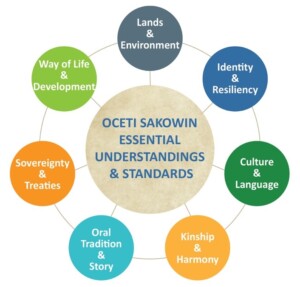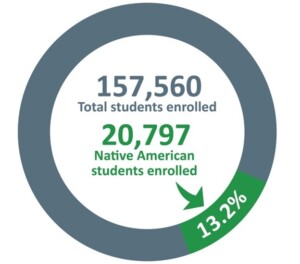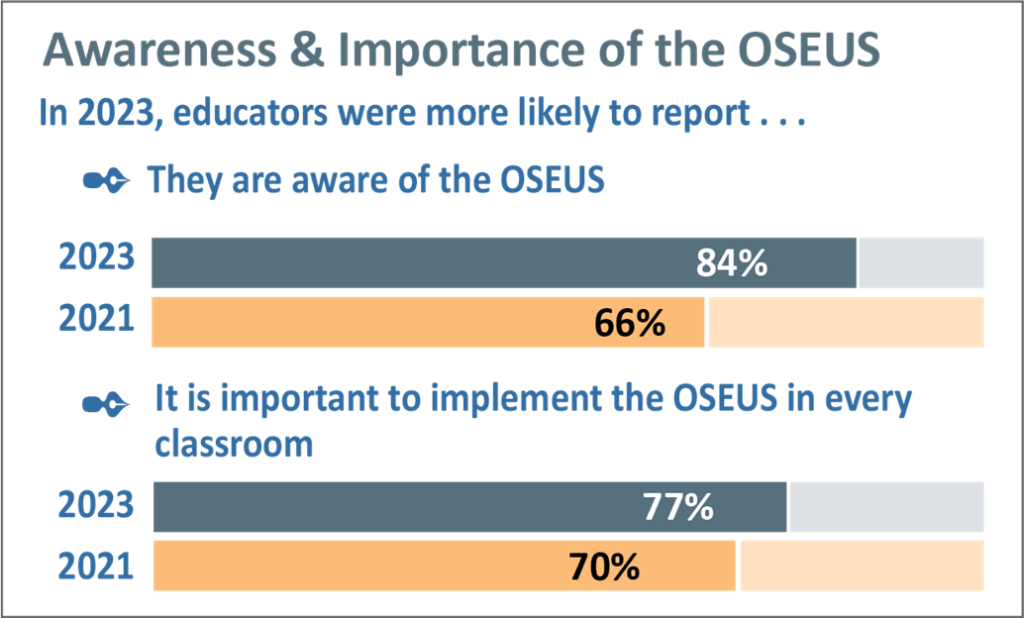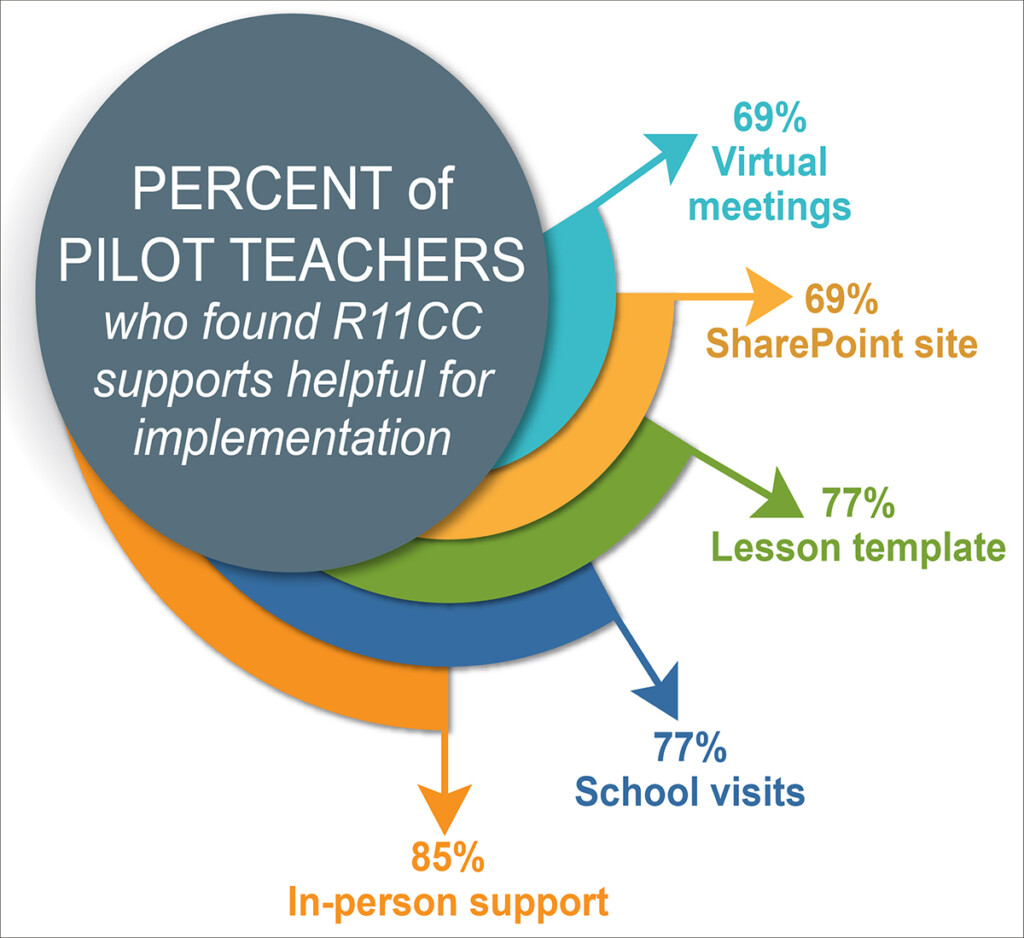Have you ever wanted to accomplish a task but couldn’t find much guidance on how to successfully achieve it? This was the problem many schools and educators were experiencing in South Dakota. Six years ago, the Oceti Sakowin Essential Understandings and Standards (OSEUS) were approved by the State Board of Education Standards based on legislation passed in 2007.

Figure 1. Oceti Sakowin Essential Understandings & Standards
Despite implementation efforts such as the WoLakota Project that have helped individual teachers, many others needed additional support to figure out how to incorporate these important lessons across their curriculum.
Adding to that, with various requirements, regulations, and contextual needs and opportunities, it is difficult for educators serving Native American students to understand and prioritize evidence-based practices that best support Indigenous students. Recognizing the need to develop, model, and scale policies that embrace Indigenous students’ intelligence and culture and to make integration of the OSEUS easier, the South Dakota Department of Education (SDDOE) and the South Dakota Department of Tribal Relations, Office of Indian Education (SD DTR-OIE) began a partnership with the Region 11 Comprehensive Center (R11CC). An important element of the partnership was collaboration with Tribal representatives, seeking their advice and collaboration on approaches to improve the educational experiences of Native American students.
The partnership began with a focus on investigating three factors that contribute to Native American student success—identity affirmation, language revitalization, and wellness. The state had already laid the groundwork to address identify affirmation with the creation of the OSEUS. Comprising seven standards, the OSEUS convey the rich history of the Oceti Sakowin (oh-CHEH-tee shaw-KOH-we) in South Dakota, including crucial ideas of culture and traditions, and descriptions of contemporary ways of life. Oceti Sakowin refers collectively to the Lakota, Dakota, and Nakota people, many of whom call South Dakota home, and together make up over 13% of South Dakota’s student body. The standards are due for a revision later this year, and one of the goals of the R11CC’s partnership’s work is to generate information to assist in that process.

Figure 2. 2022 K–12 student enrollment
Classroom integration of the OSEUS content acknowledges the Oceti Sakowin students’ language, cultural traditions and identity, belief system, and history. For non-Native American students and educators, integration of the OSEUS helps everyone develop a richer understanding of the history and contemporary context of their state, in addition to gaining knowledge of the wide variety of historical sources that can be used to interpret the state’s past. When all students can understand and appreciate the history of the Oceti Sakowin, school culture can improve, said Fred Osborn, director of the SD DTR-OIE.
When the standards were first developed, they did not come with implementation guidance or legislative mandate. South Dakota has been working to address these

Figure 3: Comparison of 2021 and 2023 Needs Assessment Educator Survey results
challenges and is making progress, according to a report comparing the 2021 and 2023 needs assessment survey responses from teachers and administrators. The survey found that educators and administrators reported a greater awareness of the OSEUS in 2023. While the findings come from a fairly small sample size (less than 10% of educators and 20% of administrators statewide), responding educators reported using each of the seven standards more often in 2023, and said they had a greater understanding of the OSEUS, with 54% reporting that they understood them well enough to teach—an increase of 18 percentage points from 2021. There was also a 17 percentage point increase in the number of educators who reported using OSEUS lesson plans in their classrooms in the 2023 survey.
Building on this momentum is one of the main priorities for the partnership, which has focused on creating resources to support the implementation of the OSEUS, supporting educators in their integration of the OSEUS into content standards, and building a network of educators across the state to share resources as well as learn from and support one another. For example, educators identified school and district accountability as an important foundation for statewide implementation of the OSEUS in the 2023 needs assessment survey. “They need to be enforced just as any other subject,” said one teacher; another agreed they should be “a requirement across all South Dakota schools.” Educators identified aligning the OSEUS across content areas and grade levels as another important support. “Getting them to align to the standards I have to teach is the big problem. They need to fit within the scope and sequence of my teaching,” a different educator explained in the same survey.

Figure 4: South Dakota Bright Spots Project Timeline
Building Capacity and Confidence
In 2021, the R11CC-led team developed an Integration Guide to help teachers implement the OSEUS. The Integration Guide is an innovation configuration map that uses evidence-based practices to support the implementation of the OSEU standards. A working group, which supported the creation of the guide, was made of 25 K–12 educators and administrators from across the state who teach various content areas and come from public, private, and Bureau of Indian Education (BIE) schools.
During the 2021–22 school year, teachers in seven schools trialed the Integration Guide. They found that professional support and resources were essential to incorporating the OSEUS into their content standards—and recommended supporting implementation by creating structures that allow dedicated time for teachers to collaborate and learn from one another.

Figure 5: Pilot Study Survey Findings
Based on the trial feedback, a pilot study with three schools began in the 2022–23 school year. Sixteen elementary school teachers participated, from two public schools and one BIE school. The study used a team coordinator approach to incorporate the Integration Guide. The R11CC worked directly with the team coordinators, bringing them together for dedicated collaboration time and supporting them when they identified resource needs. The coordinators then worked with teams of teachers in their schools to share the information. Teachers seeing other teachers, like them, integrate the standards gave them the support and confidence to do it themselves. “To see the pilot teachers collaborating and the team coordinators collaborating as they are, they’re unstoppable,” said Michelle Nelin-Maruani, a South Dakota teacher and R11CC partner.
Pre- and post-pilot assessments found that participants reported an increased understanding of the standards as well as increases in their confidence to implement them, in their ability to build student understanding, and in their access to quality lesson plans. Over 90% of the participants reported that the guide supported their implementation, and many suggested ways to improve its useability. Participants also shared a desire for additional resources and supports that are easily accessible and more closely aligned to grade-level content standards.
The R11CC project has provided opportunities for the standards to be incorporated effectively, and “allows teachers to connect with the standards in a meaningful way by creating a rubric with criteria to move back and forth within the document, giving educators a chance to recognize where their own personal understanding is and detect any possible biases they may have,” explained educator Jonni R. Hertel, a project partner who is a member of the Cheyenne River Sioux Tribe and was the 2023 Rapid City Area Schools’ Teacher of the Year.
Resources by Teachers for Teachers
During the pilot, one challenge that arose was the different lesson plan templates used by each South Dakota district. To support collaboration and sharing of resources, the R11CC created a lesson plan template, which is now available on the SD DTR-OIE website and included as a resource in the SD DTR-OIE OSEUS Online Training Course. In addition, the R11CC has continued work to help pilot teachers develop quality, shareable lesson plans to support OSEUS integration, with the goal of long-term, statewide scalability in the future, managed by the SD DTR-OIE.
While the R11CC project is helping develop these structures, the project’s longevity will depend on educators across South Dakota. The goal remains sustainable, statewide implementation, which will require South Dakotans to continue to build knowledge and implementation supports. “You’re really kind of planting the seed, and then it spreads,” said Osborn.
Contact
For more information about implementing the OSEUS in South Dakota, please contact the R11CC co-directors, Joe Simpson and Susan Shebby.
Want to share this story with others? Download a PDF version here.
